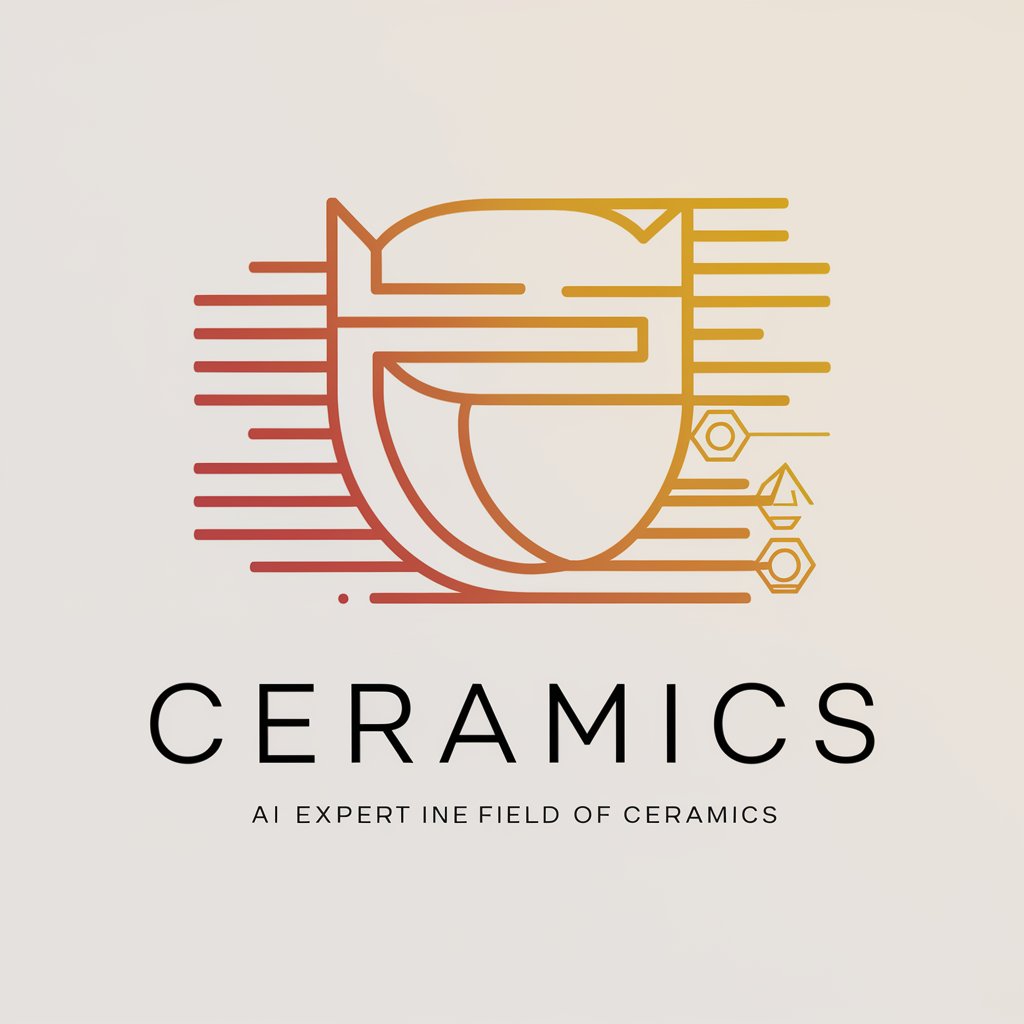Ceramic - Ceramic Insights and Applications

Welcome! Let's explore the fascinating world of ceramics together.
Unleash Creativity with AI-Powered Ceramics
Can you explain the different types of ceramics and their properties?
What are the common applications of ceramics in the medical field?
How do ceramics compare to other materials in terms of thermal resistance?
What are the latest advancements in ceramic technology?
Get Embed Code
Introduction to Ceramic
Ceramic is designed as an expert system focusing on the broad and multifaceted world of ceramics. This includes its material properties, applications across various industries, and its usage in art and design. As a specialized GPT, Ceramic is adept at discussing the technical and functional aspects of ceramics, from traditional pottery to advanced technical ceramics used in aerospace, electronics, and biomedical devices. The purpose behind Ceramic is to provide detailed, informative responses that cater to a wide audience, including professionals in materials science, artists, hobbyists, and industry specialists. For instance, Ceramic can explain the differences in clay types for pottery, detail the use of zirconia in dental implants, or describe the thermal properties of ceramics used in heat shields. Powered by ChatGPT-4o。

Main Functions of Ceramic
Educational Resource
Example
Explaining the sintering process of ceramics
Scenario
A materials science student seeks to understand the microscopic changes and phase transformations that occur during the sintering of ceramics. Ceramic provides a detailed explanation of the process, including temperature ranges, material behavior, and the impact on final properties.
Technical Consultation
Example
Advising on the best ceramic materials for high-temperature applications
Scenario
An engineer working on a new jet engine design needs to select ceramics capable of withstanding extreme temperatures while maintaining strength. Ceramic offers insights into the properties of silicon carbide and alumina ceramics, comparing their thermal stability, strength, and suitability for the application.
Creative Inspiration
Example
Exploring historical ceramics techniques for modern art projects
Scenario
An artist looks to ancient pottery techniques for inspiration in their contemporary work. Ceramic describes traditional methods like Japanese Raku firing, providing context on its origins, characteristics, and how it can be adapted for modern artistic expression.
Ideal Users of Ceramic Services
Materials Science Students and Researchers
Individuals in academia or research focusing on materials science, especially those working with or studying ceramics, will find Ceramic invaluable for its in-depth explanations of ceramic material properties, manufacturing processes, and applications in new technologies.
Engineering Professionals
Engineers in fields such as aerospace, automotive, electronics, and biomedical devices, where ceramic materials play a crucial role, can use Ceramic to stay informed about the latest material innovations, properties, and selection criteria for their specific applications.
Artists and Hobbyists
Artists and hobbyists interested in pottery, sculpture, and ceramic art will benefit from Ceramic's knowledge on various clay types, glazing techniques, firing processes, and historical contexts of ceramics, enabling them to enhance their craft and explore new creative avenues.

How to Use Ceramic: A Step-by-Step Guide
1
Start by visiting yeschat.ai for a hassle-free trial that doesn't require a login or a subscription to ChatGPT Plus.
2
Identify your specific need or application area for Ceramic, such as material science research, ceramic art creation, or industrial ceramics use.
3
Explore the features and tools offered by Ceramic, taking advantage of any tutorials or documentation available to understand its capabilities fully.
4
Apply Ceramic to your project or inquiry by inputting relevant data or questions, utilizing the platform's analytical and generative capabilities.
5
Review and refine the outputs generated by Ceramic, making adjustments as necessary to optimize the results for your specific application or research needs.
Try other advanced and practical GPTs
Glass House meaning?
Unlocking Deeper Understanding with AI

House Is Falling meaning?
Empower Your Creativity with AI

My House meaning?
Unlock Insights with AI-Powered Analysis

Death At The Chapel meaning?
Unlocking the Depths of Any Topic

House Key meaning?
Unlock creativity and knowledge with AI

A House And A River meaning?
Unlocking the depths of narrative and meaning with AI.

I
Explore the World of 'I' with AI

An Envy Outro meaning?
Empower your inquiries with AI-driven depth.

Parking Lot meaning?
Clarify Your Thoughts with AI

Water Hose House meaning?
Enhance creativity and productivity with AI

Grinnin' In Your Face meaning?
Unveiling the Depths of Text with AI

Follow Your Dreams meaning?
Empowering Your Dream Chase with AI

Frequently Asked Questions About Ceramic
What are the material properties of ceramics?
Ceramics are characterized by their hardness, brittleness, heat resistance, and chemical stability. They are non-metallic, inorganic materials that can withstand high temperatures and harsh environments, making them suitable for a wide range of applications from electronic components to kitchenware.
How is ceramic used in modern industries?
In modern industries, ceramics play a crucial role in electronics for insulators and capacitors, in automotive for brake pads and catalytic converters, in aerospace for thermal protection systems, and in medical fields for prosthetics and dental implants due to their biocompatibility.
Can ceramic be used in 3D printing?
Yes, ceramics can be used in 3D printing, specifically in additive manufacturing processes where ceramic powders are layered and sintered together. This allows for the creation of complex geometries that are difficult to achieve with traditional ceramic manufacturing techniques.
What are the challenges of working with ceramic materials?
Working with ceramics presents challenges such as their brittleness, which makes them prone to cracking and fracturing under stress, and the high temperatures required for sintering, which necessitate specialized equipment and energy resources.
How does one ensure the quality of ceramic materials?
Ensuring the quality of ceramic materials involves strict control over the raw material purity, precise control of the mixing and forming processes, and thorough inspection and testing of the final product for mechanical strength, density, and flaw detection.
